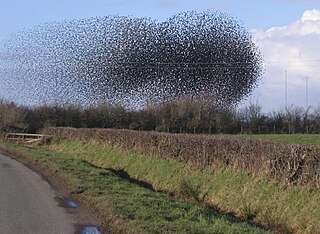Related Research Articles

Samuel Chao Chung Ting is a Chinese-American physicist who, with Burton Richter, received the Nobel Prize in 1976 for discovering the subatomic J/ψ particle. More recently he has been the principal investigator in research conducted with the Alpha Magnetic Spectrometer, a device installed on the International Space Station in 2011.

Exotic hadrons are subatomic particles composed of quarks and gluons, but which – unlike "well-known" hadrons such as protons, neutrons and mesons – consist of more than three valence quarks. By contrast, "ordinary" hadrons contain just two or three quarks. Hadrons with explicit valence gluon content would also be considered exotic. In theory, there is no limit on the number of quarks in a hadron, as long as the hadron's color charge is white, or color-neutral.
This is a timeline of subatomic particle discoveries, including all particles thus far discovered which appear to be elementary given the best available evidence. It also includes the discovery of composite particles and antiparticles that were of particular historical importance.

The Belle experiment was a particle physics experiment conducted by the Belle Collaboration, an international collaboration of more than 400 physicists and engineers, at the High Energy Accelerator Research Organisation (KEK) in Tsukuba, Ibaraki Prefecture, Japan. The experiment ran from 1999 to 2010.
Objective-collapse theories, also known as models of spontaneous wave function collapse or dynamical reduction models, are proposed solutions to the measurement problem in quantum mechanics. As with other theories called interpretations of quantum mechanics, they are possible explanations of why and how quantum measurements always give definite outcomes, not a superposition of them as predicted by the Schrödinger equation, and more generally how the classical world emerges from quantum theory. The fundamental idea is that the unitary evolution of the wave function describing the state of a quantum system is approximate. It works well for microscopic systems, but progressively loses its validity when the mass / complexity of the system increases.
Light dark matter, in astronomy and cosmology, are dark matter weakly interacting massive particles (WIMPS) candidates with masses less than 1 GeV. These particles are heavier than warm dark matter and hot dark matter, but are lighter than the traditional forms of cold dark matter, such as Massive Compact Halo Objects (MACHOs). The Lee-Weinberg bound limits the mass of the favored dark matter candidate, WIMPs, that interact via the weak interaction to GeV. This bound arises as follows. The lower the mass of WIMPs is, the lower the annihilation cross section, which is of the order , where m is the WIMP mass and M the mass of the Z-boson. This means that low mass WIMPs, which would be abundantly produced in the early universe, freeze out much earlier and thus at a higher temperature, than higher mass WIMPs. This leads to a higher relic WIMP density. If the mass is lower than GeV the WIMP relic density would overclose the universe.

Nicholas Harrison FRSC FinstP is an English theoretical physicist known for his work on developing theory and computational methods for discovering and optimising advanced materials. He is the Professor of Computational Materials Science in the Department of Chemistry at Imperial College London where he is co-director of the Institute of Molecular Science and Engineering.

Active matter is matter composed of large numbers of active "agents", each of which consumes energy in order to move or to exert mechanical forces. Such systems are intrinsically out of thermal equilibrium. Unlike thermal systems relaxing towards equilibrium and systems with boundary conditions imposing steady currents, active matter systems break time reversal symmetry because energy is being continually dissipated by the individual constituents. Most examples of active matter are biological in origin and span all the scales of the living, from bacteria and self-organising bio-polymers such as microtubules and actin, to schools of fish and flocks of birds. However, a great deal of current experimental work is devoted to synthetic systems such as artificial self-propelled particles. Active matter is a relatively new material classification in soft matter: the most extensively studied model, the Vicsek model, dates from 1995.
The SP formula for the dephasing rate of a particle that moves in a fluctuating environment unifies various results that have been obtained, notably in condensed matter physics, with regard to the motion of electrons in a metal. The general case requires to take into account not only the temporal correlations but also the spatial correlations of the environmental fluctuations. These can be characterized by the spectral form factor , while the motion of the particle is characterized by its power spectrum . Consequently, at finite temperature the expression for the dephasing rate takes the following form that involves S and P functions:
The Bousso bound captures a fundamental relation between quantum information and the geometry of space and time. It appears to be an imprint of a unified theory that combines quantum mechanics with Einstein's general relativity. The study of black hole thermodynamics and the information paradox led to the idea of the holographic principle: the entropy of matter and radiation in a spatial region cannot exceed the Bekenstein–Hawking entropy of the boundary of the region, which is proportional to the boundary area. However, this "spacelike" entropy bound fails in cosmology; for example, it does not hold true in our universe.

In condensed matter physics, a time crystal is a quantum system of particles whose lowest-energy state is one in which the particles are in repetitive motion. The system cannot lose energy to the environment and come to rest because it is already in its quantum ground state. Because of this, the motion of the particles does not really represent kinetic energy like other motion; it has "motion without energy". Time crystals were first proposed theoretically by Frank Wilczek in 2012 as a time-based analogue to common crystals – whereas the atoms in crystals are arranged periodically in space, the atoms in a time crystal are arranged periodically in both space and time. Several different groups have demonstrated matter with stable periodic evolution in systems that are periodically driven. In terms of practical use, time crystals may one day be used as quantum computer memory.
Dynamic scaling is a litmus test that shows whether an evolving system exhibits self-similarity. In general a function is said to exhibit dynamic scaling if it satisfies:
Stochastic thermodynamics is an emergent field of research in statistical mechanics that uses stochastic variables to better understand the non-equilibrium dynamics present in many microscopic systems such as colloidal particles, biopolymers, enzymes, and molecular motors.

Jeremy John Baumberg, is a British physicist who is Professor of Nanoscience in the Cavendish Laboratory at the University of Cambridge, a Fellow of Jesus College, Cambridge and Director of the NanoPhotonics Centre.
In quantum computing, a qubit is a unit of information analogous to a bit in classical computing, but it is affected by quantum mechanical properties such as superposition and entanglement which allow qubits to be in some ways more powerful than classical bits for some tasks. Qubits are used in quantum circuits and quantum algorithms composed of quantum logic gates to solve computational problems, where they are used for input/output and intermediate computations.

The Penning–Malmberg trap, named after Frans Penning and John Malmberg, is an electromagnetic device used to confine large numbers of charged particles of a single sign of charge. Much interest in Penning–Malmberg (PM) traps arises from the fact that if the density of particles is large and the temperature is low, the gas will become a single-component plasma. While confinement of electrically neutral plasmas is generally difficult, single-species plasmas can be confined for long times in PM traps. They are the method of choice to study a variety of plasma phenomena. They are also widely used to confine antiparticles such as positrons and antiprotons for use in studies of the properties of antimatter and interactions of antiparticles with matter.
Toshiki Tajima is a Japanese theoretical plasma physicist known for pioneering the laser wakefield acceleration technique with John M. Dawson in 1979. The technique is used to accelerate particles in a plasma and was experimentally realized in 1994, for which Tajima received several awards such as the Nishina Memorial Prize (2006), the Enrico Fermi Prize (2015), the Robert R. Wilson Prize (2019), the Hannes Alfvén Prize (2019) and the Charles Hard Townes Award (2020).
Douglas J. Durian is Professor of Physics and Astronomy at the University of Pennsylvania. He is known for his research contributions to the field of experimental soft matter, particularly in the areas of foams and granular flows. He has held multiple visiting professorships and leaderships positions in the soft matter physics community. He is a Fellow of the American Physical Society.

An electron-on-helium qubit is a quantum bit for which the orthonormal basis states |0⟩ and |1⟩ are defined by quantized motional states or alternatively the spin states of an electron trapped above the surface of liquid helium. The electron-on-helium qubit was proposed as the basic element for building quantum computers with electrons on helium by Platzman and Dykman in 1999.
In statistical mechanics and condensed matter physics, the Kovacs effect is a kind of memory effect in glassy systems below the glass-transition temperature. A.J. Kovacs observed that a system’s state out of equilibrium is defined not only by its macro thermodynamical variables, but also by the inner parameters of the system. In the original effect, in response to a temperature change, under constant pressure, the isobaric volume and free energy of the system experienced a recovery characterized by non-monotonic departure from equilibrium, whereas all other thermodynamical variables were in their equilibrium values. It is considered a memory effect since the relaxation dynamics of the system depend on its thermal and mechanical history.
References
- ↑ Rudnick, J; Gaspari, G (1986). "The asphericity of random walks". Journal of Physics A: Mathematical and General. 19 (4): L191–L193. Bibcode:1986JPhA...19L.191R. doi:10.1088/0305-4470/19/4/004. ISSN 0305-4470.
- ↑ Rudnick, Joseph; Bruinsma, Robijn (1995). "Shape of Domains in Two-Dimensional Systems: Virtual Singularities and a Generalized Wulff Construction". Physical Review Letters. 74 (13): 2491–2494. arXiv: cond-mat/9409061 . Bibcode:1995PhRvL..74.2491R. doi:10.1103/PhysRevLett.74.2491. ISSN 0031-9007. PMID 10057941.
- ↑ Chakravarty, Sudip; Rudnick, Joseph (1995). "Dissipative Dynamics of a Two-State System, the Kondo Problem, and the Inverse-Square Ising Model". Physical Review Letters. 75 (3): 501–504. Bibcode:1995PhRvL..75..501C. doi:10.1103/PhysRevLett.75.501. ISSN 0031-9007. PMID 10060037.